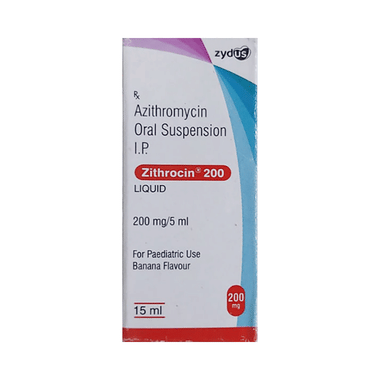Azal 200mg/5ml Syrup


Your child’s medicine at a glance
Azal 200mg/5ml Syrup works by inhibiting the growth of the infection-causing bacteria and stopping it from multiplying. As a result of this, the spread of the infection is disabled. Azal 200mg/5ml Syrup is usually given once a day, preferably in the morning. However, in the case of typhoid, it is to be given twice. Give it with or without food at about the same time each day. However, it is best given with food since children often have a sensitive stomach and could easily get a stomach upset.
Medicine dose depends on the type of infection your child has, its severity, and your child’s age and body weight. So stick to the dose, time, and way prescribed by the doctor. In case your child vomits within 30 minutes of taking this medicine, give the same dose again.
Your child may start to feel better within 2 days of regular dosing. However, you must still complete the full prescribed course of the medicine and never stop it abruptly as that may worsen your child’s condition or increase the risk of reinfection. Some of the minor and temporary side effects of this medicine include vomiting, diarrhea, nausea, and stomach pain. Usually, these episodes subside once your child’s body adapts to the medicine. However, in case these effects persist or become bothersome for your child, consult your child’s doctor without any delay.
Inform your child’s doctor about any previous episode of any allergy, heart problem, liver impairment, and kidney malfunction. Knowing the child’s medical history is critical for dose alterations and for planning your child’s overall treatment.
Uses of Azal 200mg/5ml Syrup in children
Benefits of Azal 200mg/5ml Syrup for your child
In Treatment of Bacterial infections
Side effects of Azal 200mg/5ml Syrup in children
Common side effects of Azal
- Abdominal pain
- Diarrhea
- Nausea
- Indigestion
- Vomiting
- Flatulence
- Dizziness
- Headache
- Vertigo
How can I give Azal 200mg/5ml Syrup to my child?
How Azal Syrup works
Safety advice
However, Azal 200mg/5ml Syrup is usually considered safe to use in children with mild to moderate kidney impairment. Dose modifications are generally not required in children with kidney problems.
However, discontinue immediately if signs or symptoms of hepatitis like vomiting, paleness, and weakness are observed.
What if I forget to give Azal 200mg/5ml Syrup to my child?
All substitutes
Quick tips
- Your child must complete the entire course of this medicine. Stopping too soon may cause the bacteria to multiply again, become resistant, or cause another infection.
- Give Azal 200mg/5ml Syrup with food to avoid an upset stomach.
- Encourage your child to drink plenty of water in case diarrhea develops as a side effect.
- Azal 200mg/5ml Syrup will not be effective for viral infections. However, the doctor may prescribe this medicine in case of a secondary bacterial infection. So make sure to speak to your child’s doctor first.
- Only give Azal 200mg/5ml Syrup to your child for their current infection. Never save medicine for future illnesses.
- Stop the medicine and contact the doctor immediately if your child develops an itchy rash, facial swelling, and breathing difficulties soon after the intake.
Fact Box
Interaction with drugs
Patient concerns
FAQs
What if I give too much of Azal 200mg/5ml Syrup by mistake?
Are there any possible serious side effects of Azal 200mg/5ml Syrup?
Can other medicines be given at the same time as Azal 200mg/5ml Syrup?
Can I get my child vaccinated while on treatment with Azal 200mg/5ml Syrup?
Which all lab tests should my child undergo while taking Azal 200mg/5ml Syrup on a long term basis?
Can Azal 200mg/5ml Syrup impact my child’s digestion?
Why is Azal 200mg/5ml Syrup given for 3 days?
What should I avoid while taking Azal 200mg/5ml Syrup?
Is Azal 200mg/5ml Syrup a strong antibiotic?
Can you get a yeast infection from taking Azal 200mg/5ml Syrup?
Disclaimer:
Tata 1mg's sole intention is to ensure that its consumers get information that is expert-reviewed, accurate and trustworthy. However, the information contained herein should NOT be used as a substitute for the advice of a qualified physician. The information provided here is for informational purposes only. This may not cover everything about particular health conditions, lab tests, medicines, all possible side effects, drug interactions, warnings, alerts, etc. Please consult your doctor and discuss all your queries related to any disease or medicine. We intend to support, not replace, the doctor-patient relationship.References
- Chambers HF, Deck DH. Tetracyclines, Macrolides, Clindamycin, Chloramphenicol, Streptogramins, & Oxazolidiones. In: Katzung BG, Masters SB, Trevor AJ, editors. Basic and Clinical Pharmacology. 11th ed. New Delhi, India: Tata McGraw Hill Education Private Limited; 2009. p. 801.
Marketer details
Lab tests offered by us









